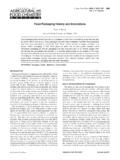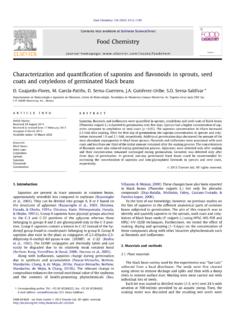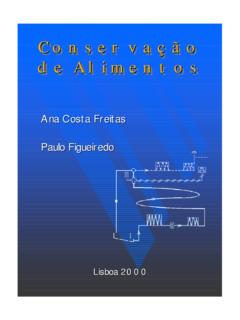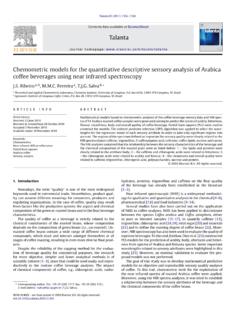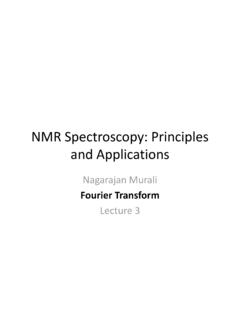Transcription of Progress in Nuclear Magnetic Resonance Spectroscopy
1 31P NMR Spectroscopy in food analysisA. Spyros*, P. DaisNMR Laboratory, Department of Chemistry, University of Crete, Voutes, Box 2208, 71003 Heraklion Crete, Greecearticle infoArticle history:Received 15 August 2008 Accepted 20 September 2008 Available online 27 September 2008 Keywords:31P NMRP hosphorusFood compositionFood analysis 2008 Elsevier All rights Introduction .. 1952. Phosphorus compounds in foods.. 1963. Experimental considerations .. The31P nucleus .. Sample preparation.. 1964. applications .. Vegetable oils .. Meat.. Fish.. Milk .. Plants .. Starch .. Phytate .. Food additives .. Lecithins .. Proteins .. Phosphates .. Organophosphorus pesticides.. 2055. Conclusions and future directions.. 205 References .. 2051.
2 IntroductionIn the past three decades, NMR has found its way into the arse-nal of spectroscopic techniques available to food scientists, and hasnow become a valuable tool in the study of a wide variety of struc-tural and compositional aspects of food chemistry and food analy-sis. This growing interest has been duly recorded in a series ofbiannual conferences devoted to applications of Magnetic reso-nance in food science that started in 1992, and continue to collections from this conference are published in abook series that represents a prime source of reference for the stateof the art in the field of NMR applications in food science[1]. Ear-lier food NMR work was covered in a series of reviews that ap-peared in Annual Reports on NMR Spectroscopy [2 4].NMRspectroscopy is currently recognized as an important tool in food0079-6565/$ - see front matter 2008 Elsevier All rights *Corresponding author.
3 Tel.: +30 2810 Spyros). Progress in Nuclear Magnetic Resonance Spectroscopy 54 (2009) 195 207 Contents lists available atScienceDirectProgress in Nuclear Magnetic Resonance Spectroscopyjournal homepage: [5,6], food analysis[7,8], and the authentication[9,10], andquality control of foodstuff[11,12]. Low field[13], solid state[14]NMR Spectroscopy , and MRI[15] applications in food science havealso been reviewed. Reviews of NMR Spectroscopy applications inspecific topics of food science and food analysis, such as milk anddairy products[16 18], meat[19 21], fruits and vegetables[22],cereals[23], lipids[24], and edible oils[25]have also factors have contributed to the rapidly increasing use ofNMR in the field of food science, including advances in high-fieldmagnet and probe design that amplified the analytical capabilitiesof modern NMR spectrometers, the successful hyphenation of NMRwith liquid chromatographic techniques in LC-NMR, and the easieraccess of food scientists to NMR spectrometers.
4 Although sensitiv-ity reasons rendered the1H nucleus as the most exploited, othernuclei such as13C and31P gained popularity lately, because of theirability to attack specific problems in food science. Specifically,31 PNMR has a long history in food science, with key papers introduc-ing the methodology in meat[26] and milk[27] from a food sci-ence perspective dating back to NMR Spectroscopy wasof course already established by then as a powerful tool in chem-istry, biology and medicine. Gorenstein was the first to summarizethe field with an emphasis in biological/biochemical applications [28], while Quin and Verkade focused on chemical characterizationand structural analysis[29].31P NMR work in food science hasbeen covered as part of general NMR reviews for milk[9], meat[19], and lipids[24], while recently a review of31P NMR work re-lated to olive oil analysis has been published[30].
5 In the present work we will focus on publications that use31 PNMR in a food science context, with emphasis on analysis. It shouldbe stressed that most foods originate either from plants or animals,and therefore there may be in certain cases significant subjectoverlap with biological chemistry, biochemistry and authors believe that any attempt to define and discriminatebetween these borders is not only impractical, but also scientifi-cally inappropriate. This report will attempt to present a compre-hensive survey of the literature available on applications of highresolution31P NMR Spectroscopy in the analysis of foods. Also, applications of solid state31P NMR will be covered for complete-ness, since it appears that lately this NMR technique is gainingmomentum in food analysis Phosphorus compounds in foodsPhosphorus is an essential element, and comprises about 1% ofthe total body weight of adults.
6 Inorganic phosphorus, Pi, and or-ganic phosphorus-containing compounds play a major role in themetabolic reactions comprising life, and are involved in significantfunctions in the human body. Hydroxyapatite, or calcium phos-phate, is the major component of bone and teeth. Phospholipidsare important structural components of cell wall , such as adenosine triphosphate (ATP) are at the heartof the cascade of reactions responsible for energy transfer in all liv-ing cells, and several proteins require phosphorylation in order tobecome active and perform their functional role. Although phos-phorus homeostasis in the human body is maintained by severaldedicated mechanisms, phosphorus deficiency is rarely a problemin healthy adults[31]. The recommended daily allowance (RDA) ofapproximately g of phosphorus is easily satisfied through foodconsumption, since foods high in protein, such as meat, milk, eggsand cereals, are also high in phosphorus.
7 This element is very com-mon in both animals and plants, where it serves the same crucialfunctions as in the human body. Phosphorus in foods is generallyeasily bioavailable, with the exception of plant seeds, where it isstored in the form of inositolhexaphosphate, IP6, also termed asphytic acid, or phytate. The digestive systems of most mammalscannot hydrolyze phytic acid, and hence its phosphorus is not di-rectly available. Apart from its natural occurrence in foods, phos-phorus compounds are also used extensively as food enjoy widespread use as surface active food ingredients,and synthetic lecithins such as ammonium phosphatides are usedas emulsifiers to improve the texture of foods such as chocolateand cocoa products. Inorganic polyphosphates are used as acidityregulators in soft drinks, to improve the water-holding capacityof processed meat, and in processed cheeses, dressings, and bakeryproducts.
8 Recently, concerns have been raised on some effects ofincreased phosphorus dietary consumption in the form of inor-ganic phosphate additives[32,33], however studies have shownmixed results and this matter is not yet Experimental The31P nucleus31P is a spin 1/2 nucleus with 100% natural abundance, and rea-sonably good natural receptivity, 391 times larger than13C. Thechemical shift range covered by31P-containing compounds coversmore than 700 ppm, from 500 to 200, with 85% H3PO4used as thereference [28,29]. However, most of the chemical com-pounds of interest to food science contain pentavalent phospho-rous in the form of phosphate, and thus appear in a relativelynarrow region between approx. 20 to 40 ppm. Trivalent phospho-rus compounds obtained through chemical derivatization of somefood components[34] appear in the range 100 200 ppm.
9 The sub-stituents on the oxygen atoms of phosphate influence the electrondensity on the phosphorus nucleus, and this has two importantconsequences for31P chemical shifts. The first is related to the31P chemical shift change of the phosphate entity, when metal cat-ions bind to oxygen, and the second consequence is the phosphatechemical shift dependence on pH changes induced by the numberof protons bound on the phosphate anion. Although this attributehas been fully exploited, for example to measure intracellular pHin animal[35] and plant tissues, it remains a factor that demandscaution when signal assignments in aqueous solutions or tissueare attempted, especially for unknown samples[36]. The longspin-lattice relaxation times T1of31P nuclei, and the variable nu-clear Overhauser enhancement (NOE) with adjacent proton nucleirepresent two additional factors that influence the ability of31 PNMR to provide quantitative results on the analysis of food mate-rials times of the order of 5 15 s re-quire repetition times five times the longest T1of more than aminute, thus experiment times can become quite long, especiallyfor low concentration samples.
10 Practical measures used to over-come this problem are: (a) the addition of paramagnetic relaxationagents, such as Cr(acac)3, to lower the T1to values lower than 5 s(b) the use of an internal phosphorus standard of known concen-tration. The latter methodology is less accurate, since it impliesthat all phosphorus species in a sample have similar T1values,which may not be the case. On the other hand, NOE effects canbe eliminated by using an appropriate pulse sequence for theacquisition of spectra, such as the inverse-gated decoupling tech-nique[37]. A recent systematic validation of quantitative31 PNMR has indicated that under careful experimental conditions,31P NMR can compete effectively with chromatographic methodsin analytical capability[38]. Sample preparationFoods are complex multicomponent systems, necessitating avariety of experimental NMR methodologies to be applied for196A.

